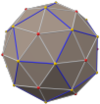Truncated icosahedron
| Truncated icosahedron | |
|---|---|
 (Click here for rotating model) | |
| Type | Archimedean solid Uniform polyhedron |
| Elements | F = 32, E = 90, V = 60 (χ = 2) |
| Faces by sides | 12{5}+20{6} |
| Conway notation | tI |
| Schläfli symbols | t{3,5} |
| t0,1{3,5} | |
| Wythoff symbol | 2 5 | 3 |
| Coxeter diagram | |
| Symmetry group | Ih, H3, [5,3], (*532), order 120 |
| Rotation group | I, [5,3]+, (532), order 60 |
| Dihedral angle | 6-6: 138.189685° 6-5: 142.62° |
| References | U25, C27, W9 |
| Properties | Semiregular convex |
 Colored faces |
 5.6.6 (Vertex figure) |
 Pentakis dodecahedron (dual polyhedron) |
 Net |


The truncated icosahedron is an Archimedean solid. It comprises 12 regular pentagonal faces, 20 regular hexagonal faces, 60 vertices and 90 edges.
This polyhedron can be constructed from an icosahedron with the 12 vertices truncated (cut off) such that one third of each edge is cut off at each of both ends. This creates 12 new pentagon faces, and leaves the original 20 triangle faces as regular hexagons. Thus the length of the edges is one third of that of the original edges.
Canonical coordinates
Canonical coordinates for the vertices of a truncated icosahedron centered at the origin are the orthogonal rectangles (0,±1,±3φ), (±1,±3φ,0), (±3φ,0,±1) and the orthogonal cuboids (±2,±(1+2φ),±φ), (±(1+2φ),±φ,±2), (±φ,±2,±(1+2φ)) along with the orthogonal cuboids (±1,±(2+φ),±2φ), (±(2+φ),±2φ,±1), (±2φ,±1,±(2+φ)), where φ = (1+√5)/2 is the golden mean. Using φ2 = φ + 1 one verifies that all vertices are on a sphere, centered at the origin, with the radius squared equal to 9φ + 10. The edges have length 2.
Geometric relations
The truncated icosahedron easily verifies the Euler characteristic:
- 32 + 60 − 90 = 2.
With unit edges, the surface area is (rounded) 21 for the pentagons and 52 for the hexagons, together 73 (see areas of regular polygons).
Applications

A football (soccer ball) comprises the same pattern of regular pentagons and regular hexagons, but is more spherical due to the pressure of the air inside and the elasticity of the ball.
This shape was also the configuration of the lenses used for focusing the explosive shock waves of the detonators in both the gadget and Fat Man atomic bombs (Richard Rhodes. Dark Sun: The Making of the Hydrogen Bomb, ISBN 0-684-82414-0. Touchstone Books, 1996., p. 195).
The truncated icosahedron can also be described as a model of the Buckminsterfullerene (C60) molecule. The diameter of the football and the Buckminsterfullerene molecule are 22 cm and ca. 1 nm, respectively, hence the size ratio is 200,000,000 : 1.
Truncated icosahedra in the arts
A truncated icosahedron with "solid edges" is a drawing by Lucas Pacioli illustrating The Divine Proportion.
See also
- spinning truncated icosahedron
- dodecahedron
- icosahedron
- icosidodecahedron
- truncated dodecahedron
- truncated rhombic triacontahedron
- hyperbolic soccerball
- fullerene
References
- Williams, Robert (1979). The Geometrical Foundation of Natural Structure: A Source Book of Design. Dover Publications, Inc. ISBN 0-486-23729-X. (Section 3-9)
External links
- Mathworld: Truncated icosahedron
- The Uniform Polyhedra
- Virtual Reality Polyhedra The Encyclopedia of Polyhedra
- Paper Models of Polyhedra Includes a paper model(net) of a Truncated Icosahedron
- Bouncing Truncated Icosahedron Virtual Reality (needs JVM)
